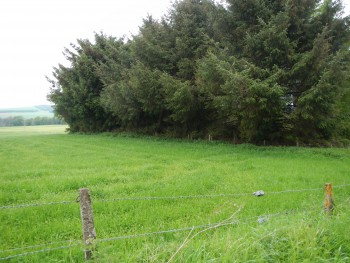- Navigation:
- Back to the Corpus index page
- RSS
Dunlappie Parish Church
Dunlappie, possible site of church
- Dedication: unknown
- Diocese of St Andrews
- Deanery of Angus
- NO 5913 6796
Summary description
Abandoned after the parish was united with Stracathro in 1612 or 1618; no structural remains.
Historical outline
Dedication: unknown
There appears to be no surviving reference to the parish church of Dunlappie earlier than the third quarter of the fifteenth century. In 1471, the church appears as a free parsonage in the lay patronage of the Douglas earls of Angus and the Leslie earls of Rothes, who had presumably acquired it through the descent to those families through co-heiresses in the mid-fourteenth century of the lordship of Abernethy. A supplication of 1471 concerning presentation to the parsonage confirms this by making specific reference to the rights of the earl of Angus pertaining to him as lord of Abernethy. The same supplication also explains that the right of presentation was exercised in alternating turns by the Douglases and the Leslies.(1) That position continued into the sixteenth century.(2) The church remained independent in lay patronage at the Reformation, when the third of its parsonage and vicarage revenues was calculated at £20.(3)
Notes
1. Calendar of Scottish Supplications to Rome, v, 1447-1471, eds J Kirk, R J Tanner, A I Dunlop (Glasgow, 1997), nos 1496, 1497.
2. Registrum Magni Sigilli Regum Scotorum, iii, 1513-1546, eds J B Paul and J M Thomson (Edinburgh, 1883), no.315.
3. Accounts of the Collectors of Thirds of Benefices, ed G Donaldson (Scottish History Society, 1949), 11.
Summary of relevant documentation
Medieval
Synopsis of Cowan’s Parishes: Parsonage in mid-fifteenth century. Patronage lay with the earls of Angus (as the lords of Abernethy) and the earls of Rothes. Continued as an independent benefice until Reformation.(1)
1471 Parsonage mentioned as in the patronage of earls of Angus (as the lords of Abernethy) and the earls of Rothes in alternate turns. Thomas Issok dead, Hugh Douglas (kinsman of earl of Angus) collated (value £12 sterling).(2)
Post-medieval
Account of Collectors of Thirds of Benefices (G. Donaldson): Third of parsonage and vicarage £20.(3)
1610 (12 Sept) The church is unplanted; the laird of Dunlappie and heritors (unnamed) to make provision for a new one.(4)
1611 (15 Apr) The church is planted with George Donaldson as minister.(5)
Statistical Account of Scotland (Rev Robert Hannah, 1791): [Stracathro and Dunlappie united in 1618] ‘The church is little better than a heap of ruins and has all the hall marks of great antiquity’.(6)
New Statistical Account of Scotland (Rev William Gerard, 1843): ‘The church was erected in 1799 and lately under repair’.(7) [no reference to remains of earlier building]
Notes
1. Cowan, The parishes of medieval Scotland, 53.
3. Donaldson, Accounts of the collectors of thirds of benefices, 11.
4. NRS Records of the Synod of Fife, 1610-1636, CH2/154/1, fol. 6.
5. NRS Records of the Synod of Fife, 1610-1636, CH2/154/1, fols. 36.
6. Statistical Account of Scotland, 1791-9, ed. J. Sinclair, Edinburgh, (1791), iv, 213.
7. New Statistical Account of Scotland, 1834-45, Edinburgh and London, (1843), xi, 668.
Bibliography
NRS Records of the Synod of Fife, 1610-1636, CH2/154/1.
Calendar of Scottish Supplications to Rome 1447-71, 1997, ed. J. Kirk, R.J. Tanner and A.I. Dunlop, Edinburgh.
Cowan, I.B., 1967, The parishes of medieval Scotland, (Scottish Record Society), Edinburgh.
Donaldson, G., 1949, Accounts of the collectors of thirds of benefices, (Scottish History Society), Edinburgh.
Hay, G., 1957, The Architecture of Scottish Post-Reformation Churches, 1560-1843, Oxford.
New Statistical Account of Scotland, 1834-45, Edinburgh and London.
Statistical Account of Scotland, 1791-9, ed. J. Sinclair, Edinburgh.
Architectural description
Dunlappie remained an independent parsonage in the patronage of the earls of Angus and the earls of Rothes throughout its medieval history.(1) At a date variously given as 1612(2) or 1618(3) the parish was united with that of Stracathro, and the church at Dunlappie appears to have passed out of use and was allowed to fall into ruin soon afterwards.
There are no structural remains of the church, but the site of the churchyard, at NO 5913 6796, was partly investigated in 1999, in advance of works associated with the planned replacement of Dunlappie Bridge, when an enclosure bank and human remains were located.(4) Subsequently, in 2000, excavation was undertaken at the south end of the churchyard, in advance of work on Dalhousie Bridge, when sections were cut through the boundary bank and ditch and three burials were located.(5)
Notes
1. Ian B. Cowan, The Parishes of Medieval Scotland (Scottish Record Society), 1967, p. 53.
2. New Statistical Account of Scotland, 1834-45, vol. 11, p. 662; Ordnance Gazetteer of Scotland, vol. 2, 1882.
3. Statistical Account of Scotland, 1791-9, vol. 4, p. 209.
4. M. Cressey (CFA Archaeology), Discovery and Excavation in Scotland, Edinburgh, 1999, p. 14.
5. J. Millar (Headland Archaeology), Discovery and Excavation in Scotland, Edinburgh, 2000, p. 13.
Map
Images
Click on any thumbnail to open the image gallery and slideshow.




